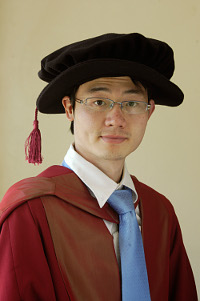Application of adaptive cross approximation with the boundary element method for numerical investigations of microbubble dynamics.

Zhiwei Fu has passed his PhD viva at the Wessex Institute of Technology, with a thesis entitled ‘Application of adaptive cross approximation with the boundary element method for numerical investigations of microbubble dynamics’. His external examiner was Dr. Qianxi Wang from the University of Birmingham and the internal examiner was Dr. Stavros Syngellakis.
Prior to the PhD study at WIT, Zhiwei Fu received his Master of Science from the University of Dundee and his Bachelor of Engineering from Tongji University, both in the main field of Civil Engineering. He came to WIT in 2010 and started a PhD programme under the supervision of Prof. Viktor Popov.
Zhiwei’s research work was funded by the European FP7-SONO project, with the aim of building an efficient biomedical pilot line for cleaning medical textile to reduce the possibility of infections. His main task was to develop a fast model for simulating the evolution of microbubbles in a flowing liquid and conduct the numerical investigations of the dynamics of multiple bubbles with or without the effects of an adjacent solid boundary.
The numerical model was developed using the indirect boundary element method (IBEM). The adaptive cross approximation (ACA) was applied to accelerate the solution of the boundary integral equations (BIE). A new method for mosaic partitioning was proposed as part of the implementation of the ACA algorithm. It was based on a binary key system, which represented a hierarchical cluster tree and helped to identify the condition of admissibility within the H-matrix produced by the boundary element method (BEM). The employed ACA approach proved to be efficient even for relatively small problems with O(103) degrees of freedom. As the size of the problem grew, the superior performance of the fast approach became more noticeable compared with that of the conventional boundary element method (CBEM). By applying the ACA approach, the dense matrices obtained via the collocation scheme were successfully compressed, and the developed model became capable of investigating efficiently the time-dependent evolution process for a relatively large number of bubbles e.g. O(102).
The dynamics of the bubble cavitation along a solid wall was investigated with respect to wave amplitude, wave frequency, the standoff distance, ambient temperature and the liquid properties. By understanding how the physics of the bubble changed with these parameters, the knowledge of the relations between the microscale processes and the macroscale parameters in sonochemical reactors used for impregnation of fabric with nanoparticles could be significantly improved. The analysis of multiple bubble dynamics also revealed that a bubble cloud with high bubble volume fraction and broad size distribution could initiate a strong interaction with the adjacent boundaries.
Both examiners congratulated Zhiwei on the work presented and recommended that he be awarded the degree Doctor of Philosophy.

 Wessex Institute
Wessex Institute